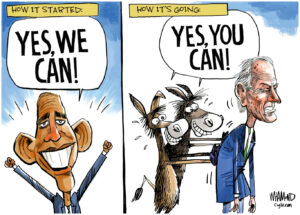House GOP, News Media Fail to Inform American Public on Budget Deficit
There are two national deficits, and both are in good if not excellent condition. Every day that the House has debated the public debt limit, President Barack Obama has cited this fact. No opponent pays any attention.
Readers scarcely need to be told that this article will be distributed on the eve of the global economic crisis generally foreseen as the consequence of the United States’ apparently imminent failure to meet the legal limit of its national debt.
The American public and the agencies of official and private finance have been assaulted for months with professional and partisan arguments concerning the size and threat of the debt. The disagreements arise from social and ideological differences dividing the American political parties, directly or indirectly concerning spending issues and the allocation of public funds.
These expenditures consistently are presented in the debate (and naturally on television and in the written press) without clear definition, explanations or comparisons that could provide an easily understood explanation of what the figures mean in relation to one another, or to other government expenditures, or to the fundamental sums of government, thus giving the non-professional a grasp of the true significance of the sum discussed.
Dean Baker of the Center for Economic and Policy Research in Washington cites a CNN poll in 2011 that revealed the typical American thinks foreign aid makes up 10 percent of the national budget. That’s a lot of money, isn’t it? The nation’s actual foreign aid expenditure is less than one percent of the U.S. budget.
I am myself a victim of this problem, having little natural mathematic aptitude. What follows exploits the knowledge and research of my gifted wife, together with a terse and brilliant article — and proposal — just published in the American Web magazine Truthout by Dean Baker (Oct. 15, 2013). He is a macroeconomist and former member of the Bucknell University faculty.
Start with the budget. Just before writing these words, I watched a member of the Republican radical caucus in the House of Representatives tell a CNN reporter that it is desperately urgent for America to halt our plunge into a “bottomless” and “endlessly increasing” national deficit.
He was quite wrong. There are two national deficits, and both are in good if not excellent condition. Every day that the House has debated the public debt limit, President Barack Obama has cited this fact. No opponent pays any attention.
The first of the two deficits owed by the U.S. is the cumulative debt racked up over many years, the public debt. Today this structural debt has ballooned to $18.7 trillion as of September 30, 2013 — but its percentage of what the country actually earns remains essentially the same. The figures have “ballooned,” but the percentages are unchanged. Thus the debt is currently 77 percent of Gross Domestic Product (the aggregate worth of what the nation produces each year), and that percentage is presently stable. With tax revenues increasing by 15 percent in 2013, bringing more money into the Treasury, the structural deficit is projected actually to drop this year to $16 trillion by the end of 2013, according to Bloomberg.
For comparison, in Japan the public debt to GDP ratio is one of the highest in the world, at 214.3 percent. The key European countries are much lower — the U.K. stands at 88.7 percent, France at 89.9 percent, Germany 81.7 percent. All are higher than the U.S. and rising. Italy is the laggard at 126.1. These figures are from the CIA World Factbook 2012.
Our second national deficit is the current budget deficit, the one most of the political arguments are about. This is the annual increase or decrease in revenues over spending. These deficits are dropping significantly in Western Europe, thanks to current austerity programs.
But the most important decrease is being registered in the United States! This is thanks to increased revenues and enforced spending cuts such as the sequester. The U.S. budget deficit has literally halved in the last two years. Today it stands at 4 percent of GDP. The figure is projected to shrink to 3.4 percent next year. This is close to the 3.3 percent average maintained over the past 30 years.
In Europe, a 3 percent deficit is held as the optimum budget target for all members of the European Union. Only Germany has now managed to come in under that figure. The U.K. and France are struggling to come under 5 percent. Many European countries’ deficits are around 8 percent, and their governments envy the U.S.
What can be done about the abysmal and extremely dangerous ignorance of Americans about what the figures they cite actually mean. For this, Professor Baker has a brilliant and simple answer. The New York Times (and the Washington Post, as the other leading national newspaper) can solve the problem in a matter of weeks.
Baker writes, “There is no excuse for budget reporting that does not actually inform its audience. … There is no reporter at any major news outlet who can’t turn a dollar amount into a percentage of the budget in seconds. … No reporter will say with a straight face that any substantial percentage of their readers has any clue what it means when they write about a $40 billion cut to food stamps over the next decade.”
Baker says: Tell readers every time what it means! Tell them the percentage of the national budget each significant figure actually represents. Do this is as a matter of newspaper policy! If just those two leading newspapers adopted such a policy, other outlets might follow within days. American government and politics would be transformed! The people at last would KNOW!
Thank you, Professor Baker!
Visit William Pfaff’s website for more on his latest book, “The Irony of Manifest Destiny: The Tragedy of America’s Foreign Policy” (Walker & Co., $25), at www.williampfaff.com.
© 2013 Tribune Media Services, Inc.
Your support matters…Independent journalism is under threat and overshadowed by heavily funded mainstream media.
You can help level the playing field. Become a member.
Your tax-deductible contribution keeps us digging beneath the headlines to give you thought-provoking, investigative reporting and analysis that unearths what's really happening- without compromise.
Give today to support our courageous, independent journalists.






You need to be a supporter to comment.
There are currently no responses to this article.
Be the first to respond.